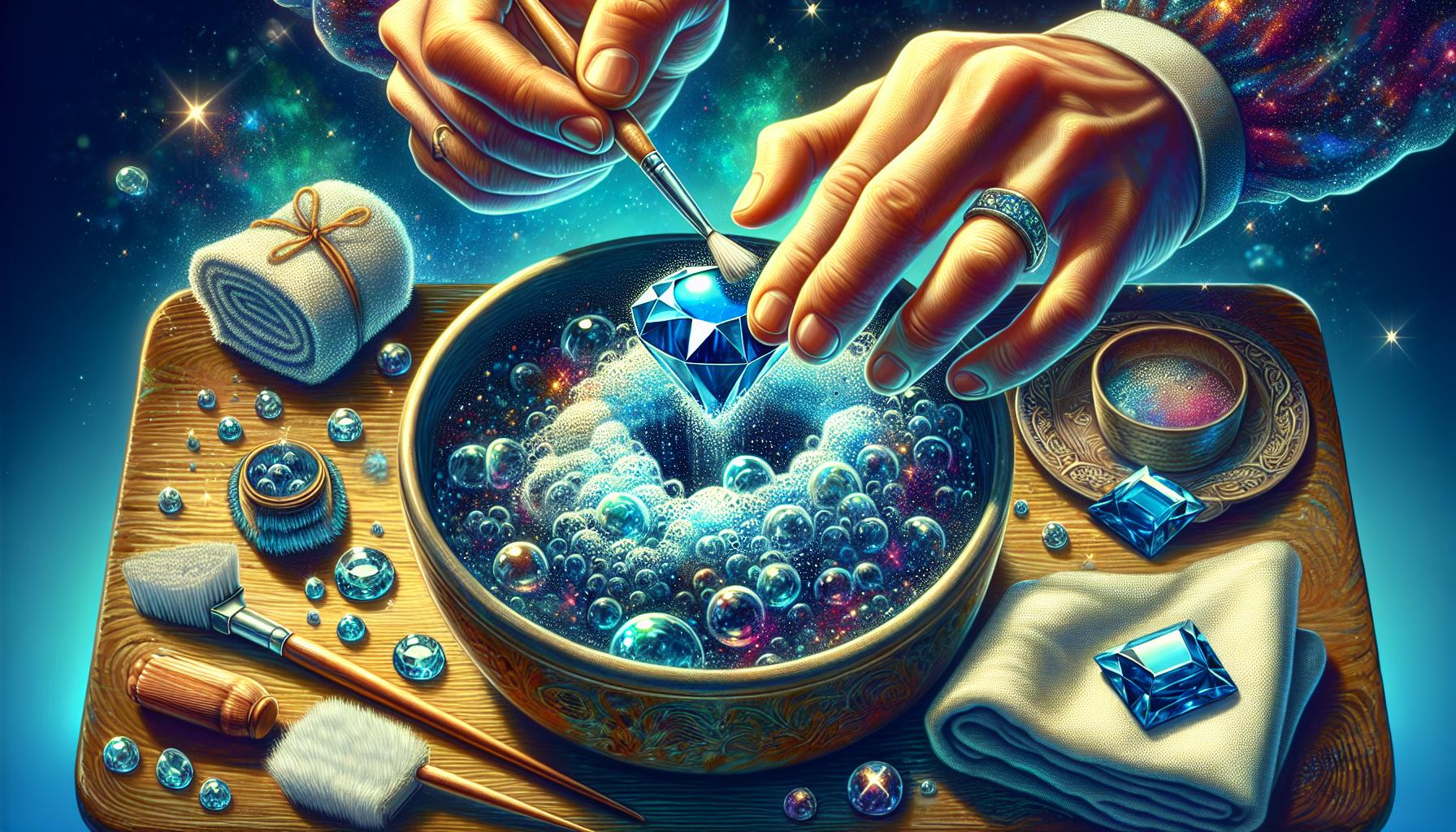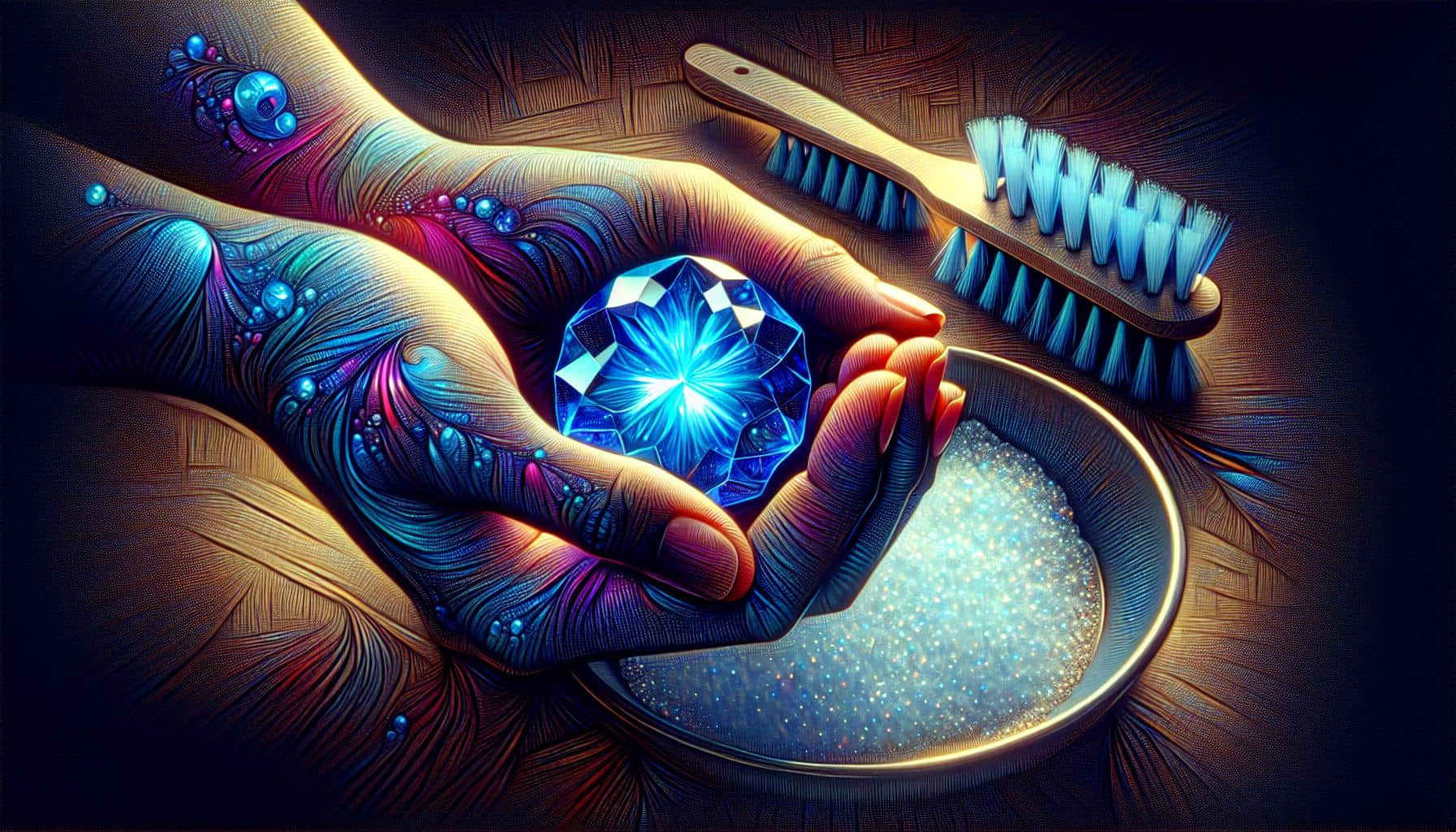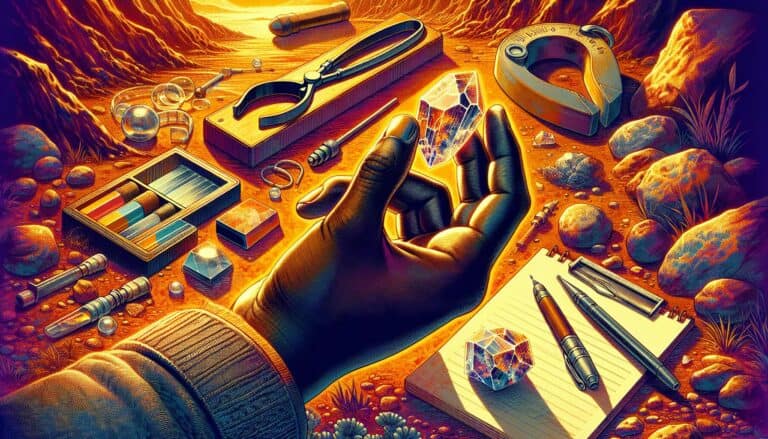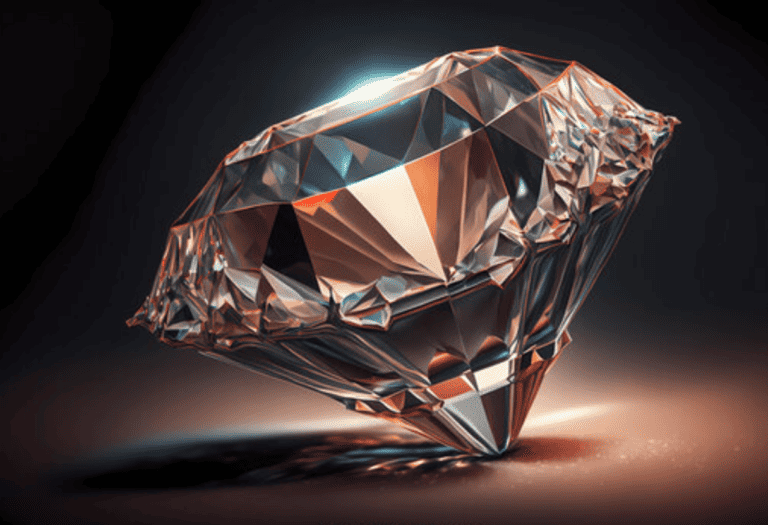Discovering the secrets of sapphire identification can be as thrilling as unearthing a hidden gem.
You’re about to embark on a journey that’ll arm you with the know-how to distinguish a true sapphire from an imposter. Whether you’re a budding gem enthusiast or simply curious, you’ll find this guide invaluable.
Sapphires, with their mesmerizing hues, are not just any stone; they’re a symbol of wisdom and nobility. Knowing how to identify a genuine sapphire ensures you’re investing in a piece of timeless beauty.
Let’s dive into the world of sapphires and learn the tricks to tell them apart from their less precious counterparts.
Identifying a true sapphire involves checking for no air bubbles, no streak on unglazed porcelain, slight magnetic reaction, hardness of 9 on Mohs scale, birefringence, transparent to opaque diaphaneity, refractive index of 1.76-1.77, and specific gravity around 4.00.
How to Identify Sapphires Through Testing
When you set out to identify a sapphire, a series of tests can be performed to determine its authenticity. It’s not just about the beauty and color; it’s about understanding the physical and optical properties that make sapphires unique. Let’s delve into the testing methods that’ll help you spot the real deal.
Visual Inspection
Start with a visual inspection under good lighting. Look for inconsistencies such as air bubbles, which are not found in natural sapphires. Also, observe the stone’s color. Sapphires come in various shades, but synthetic versions often have an unnaturally vivid hue.
The Streak Test
With the streak test, you’ll scratch the gemstone across a piece of unglazed porcelain tile. True sapphires leave no streak, while imposter stones often leave a colored trail. This should be done with care to prevent damaging the gem.
Magnet Test
Though not a definitive test, the magnet test can sometimes give clues. Run a strong magnet over the stone. A faint magnetic reaction might be seen in natural sapphires due to traces of iron, while a strong reaction may indicate a synthetic or treated stone.
Hardness Test
Sapphires are known for their hardness, rating a 9 on the Mohs scale. This test involves seeing if the stone can scratch materials of known hardness or be scratched by them. Use caution as this test may damage the stone or other materials.
Birefringence Test
Birefringence is the splitting of light as it passes through a gem. Place the sapphire over printed material; if the text appears doubled, it exhibits birefringence, a common sapphire trait, unlike synthetic counterparts which often lack this characteristic.
Checking The Diaphaneity
Examine how light passes through the sapphire. Natural sapphires can range from transparent to opaque. If the gem is too perfect in light transmission, question its authenticity; inclusions are common in natural stones.
Single or Double Refraction
While sapphires are typically known as single-refraction stones, due to their crystal structure, they might display areas of double refraction if they have strain patterns. Use a dichroscope to detect these features.
Refractive Index Test
Performing a refractive index test requires a refractometer. Genuine sapphires have a refractive index of approximately 1.76-1.77. Figures significantly outside this range may indicate that the stone isn’t a real sapphire.
Finding The Specific Gravity
Calculating the specific gravity involves a hydrostatic balance. The specific gravity for sapphire is typically around 4.00. Variations from this number might suggest the stone isn’t a genuine sapphire.
| Specific Gravity | Stone Type |
|---|---|
| Around 4.00 | Sapphire |
| Significantly Lower or Higher | Likely Imposter |
Identifying Sapphires in the Field
If you’re searching for sapphires in the field, look for telltale signs like hexagonal crystal structures and evidence of high-temperature and high-pressure formation conditions which sapphires endure.
Recognizing Potential Sapphire Rocks
Identifying potential sapphire-bearing rocks involves understanding geology. Sapphires are commonly found in igneous rocks like basalt or in alluvial deposits where rivers have eroded the original rock away. Keep an eye out for rocks with traces of these environments.
Physical Characteristics of Sapphires

Sapphires stand out due to their distinct physical properties. Understanding these characteristics can greatly refine your gemstone identification skills. These gems are traditionally blue, but their color can vary widely, including pink, yellow, and green. Typically, the more intense the hue, the more valuable the sapphire might be.
The hardness of a sapphire is remarkable, rating a 9 on the Mohs scale, which means they can scratch nearly any material, second only to diamonds. Their durability makes them excellent for everyday wear, keeping them popular in jewelry.
Look carefully at the stone’s luster; sapphires should exhibit a glass-like appearance. If your gemstone shines with a dull luster, it’s likely not a sapphire. Additionally, inclusions in the stone are common but fine sapphires have a clarity that allows light to pass through them, displaying their famed sparkle. However, be mindful as no inclusions can sometimes signal a synthetic stone.
When inspecting for authenticity, remember that sapphires are also known for their pleochroism, which means they show different colors or depths of color when viewed from different angles. This is a direct result of their unique crystal structure. Hold the gemstone at different angles under a light source to observe this effect which is not seen in counterfeit products.
Another crucial aspect is the gem’s specific gravity. Genuine sapphires have a density range of approximately 3.95 to 4.03. This property can help distinguish a real sapphire from imitations, which often have a different density. Use this characteristic along with the previously mentioned tests to ensure you’re handling an authentic sapphire.
Rough Sapphire vs Star Sapphire vs Sapphire
Sapphires are exquisite gemstones known for their rich blue hues, but they can also be found in various other colors, except red, which is classified as a ruby. When discussing sapphires, three distinct categories often arise: Rough Sapphire, Star Sapphire, and Sapphire.
Rough Sapphires are the uncut, unpolished, and natural form of the gemstone, as it emerges from the earth. They may appear rugged, with irregular shapes and rough surfaces. Rough sapphires possess inherent beauty, but they require skilled craftsmanship to be transformed into the polished gems that adorn jewelry.
Star Sapphires, on the other hand, are a mesmerizing variety known for their unique optical phenomenon called asterism. These stones exhibit a star-like pattern on their surface when viewed under a direct light source. This effect is caused by needle-like inclusions of rutile within the sapphire. The most desirable star sapphires display a sharp, well-defined star with six rays.
Sapphires encompass all varieties of the gem once they are cut and polished. They are treasured for their intense colors, exceptional durability (second only to diamonds), and symbolism of loyalty, wisdom, and nobility. Blue sapphires, in particular, are the most famous, but they can be found in various colors like pink, yellow, and even colorless.
How Are Sapphire Formed?
To genuinely appreciate the value of sapphires, it’s essential to understand their origins. Sapphires are formed deep within the earth under high temperature and pressure conditions. Corundum is the crystal form of aluminum oxide and the mineral from which sapphires arise. The presence of trace elements like iron, titanium, chromium, copper, and magnesium provides sapphires with their wide range of colors.
Here’s a simplified rundown of the creation process:
- Deep below the surface, the right mix of elements and minerals congregates.
- Over millions of years, these elements are subjected to extreme heat and pressure.
- The conditions cause the atoms to rearrange, forming crystalline structures, the beginning of sapphires.
Igneous and metamorphic rocks are primary sources for sapphire deposits. In igneous environments, sapphires can form in magmatic rocks like syenite but are more commonly found in pegmatites and certain types of volcanic rocks. In metamorphic terrains, they often form in association with schist and gneiss.
Alluvial deposits in riverbeds and floodplains are common locations where you might find these precious gemstones. Here, natural erosion processes remove sapphires from their original rock matrix, transporting them to more accessible sites.
The geological conditions required to form a sapphire are precise, and it’s this rarity that contributes to the stone’s allure and value. When identifying sapphires, knowing where and how they’re formed enriches your ability to assess their quality and authenticity.
Preparation for Sapphire Hunting
When embarking on a quest to discover the elusive sapphire, preparation is key. Armed with knowledge about their formation and typical locations, you’re already on the path to success. But before you head out, ensure you’ve got the essentials covered to make your hunt both rewarding and safe.
Gathering the Right Tools
To increase your likelihood of finding sapphires, you’ll need the right set of tools:
- Sieves and Screens: These will help you sift through the dirt and separate the gems from the soil.
- Shovels and Picks: These are essential for digging into the earth where sapphire deposits may be hiding.
- Tweezers or Gem Scoops: They come in handy for picking up small stones.
- Containers: To hold and transport your finds.
- Field Guide: Helps in identifying sapphire and other minerals on site.
Remember, having the proper gear not only aids in the discovery process but also in the preliminary identification of potential sapphire gems.
Safety Considerations
Sapphire hunting can present a series of safety risks, so you must be prepared:
- Wear Protective Gear: Durable gloves and steel-toed boots to protect against sharp rocks and equipment.
- Eye Protection: Always use safety glasses or goggles when chipping away at rock formations.
- Sun Protection: Use sunscreen and wear a hat, as you’re likely to be exposed to the sun for extended periods.
- Hydration: Bring plenty of water to stay hydrated throughout your excursion.
- First Aid Kit: Essential for any unforeseen injuries that can occur in the field.
- Inform Someone: Make sure to let someone know where you’re going and when you plan to return.
Safety is paramount, and these precautions will help to ensure a productive and injury-free adventure in your quest for sapphires.
Handling and Care of Found Sapphires

Once you’ve successfully unearthed sapphires from their natural environment, it’s crucial to handle and care for them properly. Your precious finds are not only valuable but also delicate, requiring attention to maintain their beauty and integrity.
Cleaning and Storing Sapphires
After a long day of sapphire hunting, you’ll likely be excited to see your stones in all their glory. First, though, they need a gentle cleaning to remove any dirt or debris. Here’s how you can do this effectively:
- Use a soft brush, like an old toothbrush, to gently scrub the sapphire.
- Prepare a mix of warm water and mild dish soap to soak the stones if they have a significant amount of dirt.
- Rinse them under lukewarm running water to wash off the remaining soap and dirt.
- Pat them dry with a soft, lint-free cloth.
Storing your sapphires is just as important as the initial cleaning. You’ll want to keep them safe from scratches and damage, which means proper storage is key. Consider the following tips:
- Wrap each sapphire in a soft cloth or place it in a padded gem pouch.
- If you have a gem box with individual compartments or slots, use it to prevent the stones from touching each other.
- Avoid exposing the sapphires to extreme temperatures or chemicals by storing them in a cool, dry place away from household cleaning products.
Remember, sapphires are treasures of the Earth, and with the right care, they’ll continue to dazzle for years to come. Keep yourself equipped with the necessary tools and knowledge, and handling your finds will be both rewarding and enjoyable.
Conclusion: Confirming Sapphires are Real
You’re now equipped with the know-how to identify a true sapphire and understand the importance of its care.
Remember, the allure of your gemstone hinges on how well you maintain its luster and integrity. By following the guidance on cleaning and storage, you’ll ensure your sapphire remains a timeless treasure. Treasure hunting is an adventure, and when you unearth that sparkling sapphire, you’ll feel a sense of accomplishment like no other.
So go ahead, put your newfound knowledge to the test, and enjoy the beauty of your sapphire for years to come.







